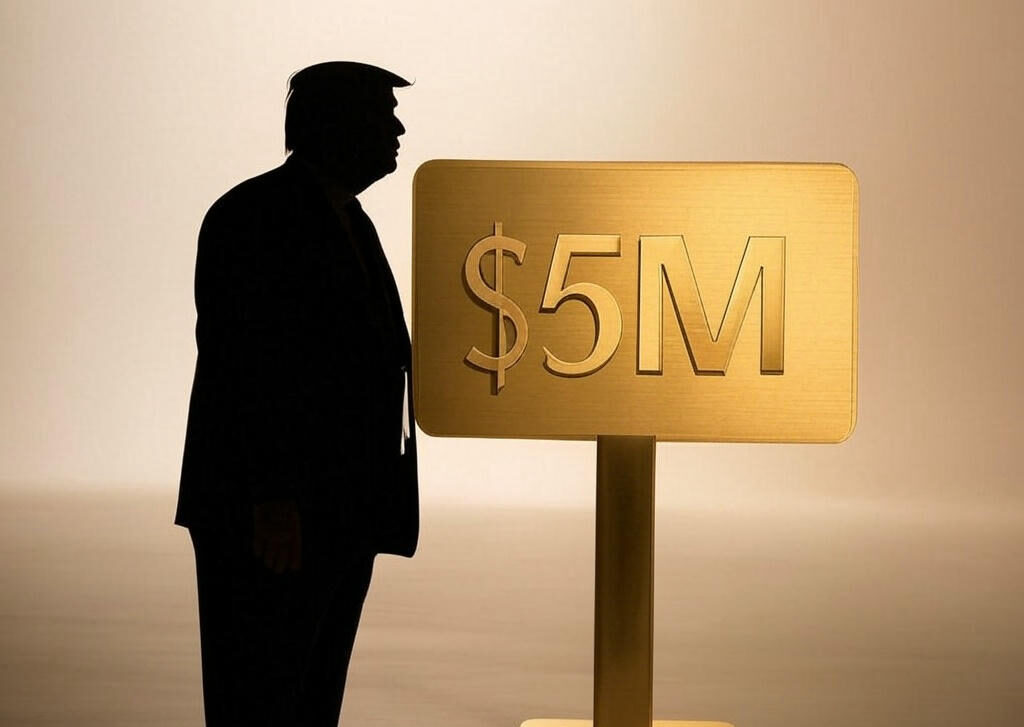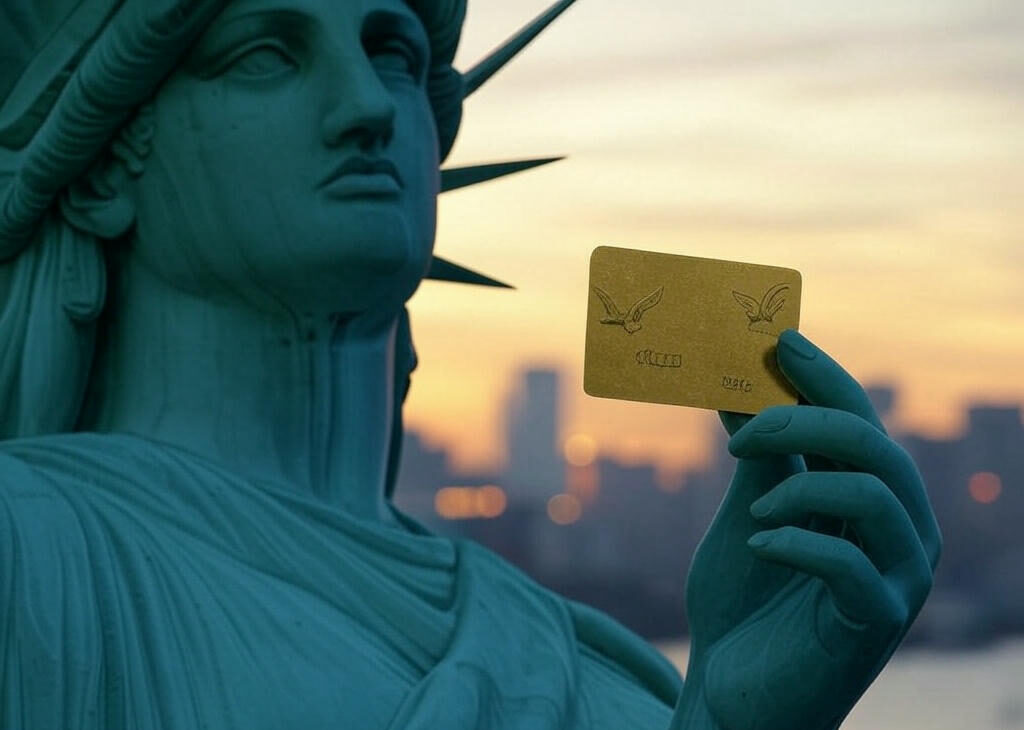Hannah Mejorada
Last updated: February 26, 2025
President Donald Trump has announced plans to introduce a “Gold Card” visa program aimed at wealthy foreign investors. The initiative would replace the existing EB-5 immigrant investor visa, offering a path to U.S. citizenship for those willing to pay $5 million. Trump claims this program would generate trillions in revenue primarily intended to reduce the national debt while bringing successful individuals who would contribute to the American economy.
The Gold Card announcement came from the Oval Office on February 25, 2025, with Commerce Secretary Howard Lutnick specifically referring to it as the “Trump Gold Card.” According to the President, cardholders would be “wealthy and successful” individuals who would spend money, pay taxes, and create employment opportunities in the United States.
This new immigration pathway represents a significant shift in U.S. immigration policy, essentially creating a direct purchase option for residency. Trump has ambitiously suggested the administration could sell up to one million of these cards, though specific implementation details and timeline remain unclear.

The Trump Gold Card represents a significant shift in U.S. immigration policy, offering wealthy foreign nationals a direct path to permanent residency through a substantial financial investment. Announced by President Donald Trump on February 25, 2025, this initiative aims to attract affluent global citizens who can make significant economic contributions to the United States.
The Gold Card emerged as President Trump’s proposed alternative to the existing EB-5 investor visa program, which has been in place for approximately 35 years. Trump unveiled the concept during a February 2025 announcement, positioning it as a “premium version of a Green Card” designed specifically for wealthy foreign investors.
Unlike traditional immigration pathways that focus on employment skills or family connections, the Gold Card centers entirely on financial investment as the qualifying criterion. The program represents an evolution in immigration policy that explicitly prioritizes economic contribution over other considerations.
The administration frames this initiative as part of a broader strategy to boost economic growth through foreign investment while simultaneously generating substantial revenue for the federal government through the application fees.
The primary qualification for a Trump Gold Card is financial: applicants must pay $5 million for the opportunity to gain permanent residency in the United States. This represents a significant increase from the investment requirements of the existing EB-5 visa program.
While traditional investor visas typically require job creation as part of the qualification process, the Gold Card proposal as announced does not explicitly mention employment generation requirements. This represents a streamlined approach focused purely on capital investment.
The program appears designed for high-net-worth individuals regardless of country of origin. Unlike many existing U.S. visa programs, the Gold Card does not include country-specific caps or quotas, potentially allowing unlimited applicants from any nation to participate.
Trump suggested the program could potentially accommodate up to 10 million participants, indicating a scale far beyond current investor visa programs.
Gold Card holders would receive permanent residency status in the United States, similar to traditional Green Card holders. This provides the legal right to live and work in the country indefinitely.
The program includes a pathway to U.S. citizenship, though specific timeframes and additional requirements for naturalization haven’t been detailed in the initial announcement. This citizenship pathway differentiates it from temporary residency programs.
Trump emphasized economic advantages for both participants and the U.S. economy. Cardholders would gain access to business and investment opportunities within the American market, while the U.S. would benefit from increased tax revenue and consumer spending.
The administration projects that participants will inject significant capital into the U.S. economy beyond the initial $5 million investment, creating economic ripple effects through taxation, business development, and discretionary spending.

President Trump’s proposed “gold card” initiative represents a significant shift in U.S. immigration policy, targeting wealthy foreign investors willing to pay $5 million for legal residency and a path to citizenship. This program would create a new category of immigration focused on attracting affluent individuals who can contribute substantially to the American economy.
The introduction of the Trump Gold Card would create a two-tiered immigration system that explicitly favors wealthy immigrants. This $5 million entry threshold would establish one of the most expensive pathways to U.S. residency in the world.
Trump and Commerce Secretary Howard Lutnick have emphasized the economic benefits, stating these wealthy immigrants would spend money, pay taxes, and create jobs. The administration believes this would drive economic growth without competing with American workers for existing jobs.
Critics argue this approach fundamentally changes immigration principles by making U.S. residency explicitly purchasable for those with significant wealth. The policy would prioritize financial assets over other qualification criteria traditionally valued in immigration processes.
The Gold Card would replace the existing EB-5 visa program, which has operated since 1990. The EB-5 program currently requires foreign investors to invest between $800,000 and $1.05 million in U.S. businesses that create at least 10 full-time jobs.
Key differences include:
The EB-5 program has faced criticism for fraud, misuse, and lengthy processing times. The Trump administration suggests the Gold Card would address these issues while generating more significant economic benefits through higher investment thresholds.
The Gold Card would provide immediate legal residency status to qualified applicants, with a defined pathway to full citizenship. This represents a significant benefit compared to other visa categories that might require longer waiting periods or lack clear citizenship pathways.
Trump described the program as attracting “high-level people” who would receive legal status in exchange for their $5 million investment. The specific timeframe for transitioning from Gold Card residency to citizenship has not been fully detailed.
Questions remain about whether Gold Card holders would face the same requirements as other immigrants seeking citizenship, such as physical presence requirements and civics examinations. Legal experts note that any new immigration pathway would require congressional approval, raising questions about implementation feasibility.
The proposed Trump Gold Card program carries significant economic considerations with its high investment threshold and focus on wealthy immigrants. The program aims to attract substantial capital influx while potentially reshaping immigration patterns and investment distribution across the United States.
The Trump Gold Card plan proposes a $5 million investment requirement, substantially higher than the existing EB-5 program’s $800,000 minimum threshold. This six-fold increase significantly alters the entry barrier for immigrant investors seeking U.S. residency.
The administration has suggested the program could potentially issue up to 1 million Gold Cards, which would represent $5 trillion in investment if fully subscribed. This capital infusion could theoretically stimulate job creation across various sectors.
Unlike the EB-5 visa which explicitly requires creating or preserving at least 10 full-time jobs, the Gold Card’s job creation requirements remain less defined in public announcements. Economic analysts question whether the program will maintain similar job creation mandates or focus primarily on the investment amount.
The Gold Card program clearly targets ultra-wealthy global investors with its $5 million price tag. Trump indicated these investors would “be spending a lot of money and paying a lot of taxes and employing a lot of people.”
Foreign investment patterns would likely shift under this program, potentially redirecting capital from other countries offering investment-based residency at lower thresholds. Countries like Portugal, Greece, and Canada could see reduced interest in their investor visa programs.
The Congressional Research Service has not yet published comprehensive analysis on the proposal, but economic experts note that while wealthy immigrants typically contribute significantly to tax revenue, the distribution of benefits may concentrate in already-affluent areas rather than economically distressed regions.
The Gold Card would create a distinct category of immigrant investors separate from traditional immigration pathways. This carve-out for wealthy immigrants would represent a small but notable percentage of overall immigration numbers.
President Trump stated the program would generate revenue to address the national debt, suggesting the administration views this as both an immigration and fiscal policy. The program might reduce overall immigration numbers while simultaneously increasing the average wealth of immigrants.
Immigration statistics would reflect this shift toward higher-income immigrants if implemented. Critics argue this could exacerbate economic inequality within the immigration system by prioritizing wealth over other selection criteria like family ties or specialized skills.
The Trump Gold Card proposal raises significant legal questions and social implications that extend beyond its economic impact. The program would fundamentally alter immigration pathways for wealthy individuals while creating distinctions between traditional permanent residency options and this new premium route.
The Trump Gold Card would require specialized vetting procedures for high-net-worth applicants. Security experts question whether the expedited nature of a premium visa might compromise thorough background checks typically conducted for immigrants.
The proposed system would likely involve financial audits to verify the legitimacy of an applicant’s $5 million payment. This verification process would need safeguards against money laundering and illicit fund transfers.
Immigration authorities would face the challenge of maintaining rigorous security standards while delivering the streamlined experience promised to Gold Card holders. The balance between expedience and thoroughness remains a central concern for national security professionals.
Foreign policy specialists note that different vetting standards for wealthy applicants could strain diplomatic relations with countries whose citizens face stricter immigration barriers.
Traditional Green Card holders enjoy permanent residency status with a pathway to citizenship after meeting specific requirements. The Trump Gold Card appears to offer similar legal residency privileges but through an accelerated, payment-based channel.
Both options provide work authorization and legal protection from deportation. However, the Gold Card’s $5 million price tag would create a clear class distinction in immigration pathways that doesn’t exist in the current system.
The replacement of the existing EB-5 investor visa program (currently requiring investments of $800,000-$1.05 million) with the much higher $5 million threshold would significantly limit access to investment-based immigration.
Current Green Card holders face country-specific quotas and waiting periods that Gold Card applicants might bypass entirely. This disparity could create a two-tiered immigration system based primarily on wealth rather than other qualifying factors.
The Gold Card concept has generated mixed reactions across political and social spectrums. Supporters view it as an economic stimulus that would bring substantial capital into the American economy while creating jobs.
Critics characterize the program as “citizenship for sale,” arguing it undermines traditional immigration values that prioritize family reunification, humanitarian concerns, and merit-based selection.
Immigration advocacy groups express concern that focusing resources on wealthy applicants could divert attention from processing regular immigration applications, which already face significant backlogs.
Global mobility experts note that similar investor visa programs exist in other nations, though typically at lower price points. The unusually high $5 million threshold positions the Trump Gold Card as one of the most expensive residency-by-investment options worldwide.
The program’s explicit targeting of the ultra-wealthy reinforces perceptions of economic inequality in immigration policy, potentially affecting public trust in the immigration system.
Trump’s proposed $5 million Gold Card sits within a global landscape of investment migration programs that attract wealthy individuals seeking residency or citizenship in exchange for financial contributions. These programs vary significantly in cost, benefits, and accessibility across different countries.
Several countries operate investment visa programs that compete with Trump’s proposed Gold Card. Portugal’s Golden Visa program requires fund investments starting at €500,000, while Greece offers golden visa residency for property purchases of €250,000. The UK previously offered an Investor Visa for £2 million before closing it in 2022 due to security concerns.
Spain maintains a popular Golden Visa program requiring €500,000 in real estate investment. Cyprus had one of the most expensive direct-citizenship programs, charging €2.2 million for citizenship until it was terminated amid scandal in 2020.
Caribbean nations offer some of the most affordable citizenship by investment options, with Dominica’s citizenship program starting at $200,000. These programs typically offer visa-free travel to numerous countries as a key benefit.
Wealthy investors increasingly seek “citizenship portfolios” with multiple passports and residency options. Political instability, tax planning, and lifestyle flexibility drive this demand.
Chinese citizens have historically dominated the investor visa market, representing over 80% of applicants in some programs. However, Middle Eastern investors, and wealthy individuals from developing economies also participate significantly.
The COVID-19 pandemic accelerated interest in these programs, with applications rising 25% globally between 2019 and 2021. High-net-worth individuals now prioritize healthcare systems and pandemic preparedness when selecting destination countries.
Remote work capabilities have also shifted preferences toward countries with digital infrastructure and favorable time zones for business operations.
At $5 million, Trump’s proposed Gold Card would be among the most expensive investor visa options globally. This positions it as a premium alternative to the existing EB-5 program, which requires investments of $800,000 to $1.05 million.
The Gold Card’s high price point may limit its appeal compared to more affordable options in countries like Portugal or Greece. However, the U.S. market offers unparalleled access to business opportunities and financial markets that smaller countries cannot match.
Unlike programs in smaller nations, Trump’s Gold Card emphasizes economic contribution through taxes and job creation rather than simple asset transfers. This approach aligns with trends toward “active investment” requirements seen in newer visa programs globally.
The proposal faces skepticism from wealth migration experts who note that political uncertainty could deter applications despite the allure of U.S. residency.
Trump’s Gold Card visa proposal faces significant hurdles related to implementation, economic impact, and ethical concerns. Critics from various sectors have raised questions about the program’s legality, potential consequences, and alignment with American values.
The proposed $5 million Gold Card visa program has attracted intense scrutiny from Congress and legal experts. The Congressional Research Service has noted potential conflicts with existing immigration frameworks that could require legislative approval rather than executive action alone.
Legal experts question whether the administration has authority to create this visa category without Congressional approval. Several lawmakers have expressed concerns about proper vetting procedures for wealthy applicants, particularly regarding Russian oligarchs and other individuals from countries with questionable financial systems.
Constitutional scholars have raised issues about effectively selling permanent legal residency, arguing it may violate equal protection principles. The proposal’s path to Lawful Permanent Resident status without traditional merit or family-based qualifications represents a significant departure from established immigration law.
Economic analysts warn the Gold Card program could exacerbate existing economic disparities. While Trump claims the program would create jobs, critics point to limited evidence that wealthy immigrants automatically generate significant employment opportunities.
Studies of similar investor visa programs show mixed results regarding job creation. During periods of high unemployment, the influx of wealthy foreign investors might primarily benefit luxury sectors rather than creating broad economic opportunities.
Some economists predict the program could inflate real estate prices in desirable areas, potentially displacing local residents. Labor organizations have voiced concerns that wealthy immigrants might bring business practices that undermine worker protections and wages.
The Gold Card proposal has sparked intense ethical debates about creating a “pay-to-play” immigration system. Critics argue it unfairly prioritizes wealth over other contributions like skills, family ties, or humanitarian needs.
Immigration advocates highlight the contrast between the Gold Card’s expedited path to citizenship and the decades-long waits faced by many legal immigrants. Media ads promoting the program have been criticized for suggesting American citizenship is essentially for sale to the highest bidder.
Human rights organizations question the fairness of fast-tracking wealthy immigrants while maintaining strict barriers for refugees and asylum seekers. The proposal’s focus on attracting the ultra-wealthy has raised concerns about creating a two-tiered immigration system that privileges financial resources above all else.
The Trump Gold Card program has generated numerous inquiries regarding its implementation, benefits, costs, and legitimacy. These questions address key concerns potential applicants and observers have about this new immigration pathway.
The Trump Gold Card provides a path to permanent residency and eventually citizenship in the United States. It offers similar benefits to a Green Card but is described by Trump as having “a higher level of sophistication.”
Trump indicated that holders would have the right to live and work in the United States legally. They would also enjoy freedom to travel in and out of the country.
The program is designed for wealthy individuals who are expected to contribute to the U.S. economy through spending, taxes, and job creation.
The Trump Gold Card requires a $5 million investment from foreign nationals. This represents a significant increase from previous investor visa programs.
The card replaces the 35-year-old EB-5 visa program, which had lower investment thresholds. The application process details have not been fully outlined beyond the financial requirement.
President Trump announced this initiative from the Oval Office on February 25, 2025, positioning it as an immigration pathway for successful business people.
The Gold Card program was announced by President Trump himself, giving it official backing from the current administration. It appears to be a formal government initiative rather than a private program.
The announcement was made from the White House, suggesting federal government involvement in its implementation. However, congressional approval may be required for full implementation.
No other government agencies or departments have been explicitly mentioned as endorsing or administering the program.
Unlike commemorative cards, the Trump Gold Card is an official immigration document with legal status. It functions as an actual visa rather than a collectible item.
The $5 million price tag differentiates it significantly from commemorative cards, which typically cost nominal amounts. The Gold Card provides actual immigration benefits and legal status in the United States.
President Trump described it as being superior to the Green Card, suggesting enhanced privileges or status.
The Gold Card itself is not an investment vehicle but rather a visa obtained through investment. The $5 million payment is a requirement for visa eligibility, not a direct investment with returns.
Trump has suggested that these investments would benefit the U.S. economy through taxation and job creation. The program appears designed to attract wealthy individuals who will make additional investments in the country.
When asked if Russian oligarchs could apply, Trump responded, “Yeah, possibly. I know some Russian oligarchs that are very nice people.”
Specific security features of the Trump Gold Card have not been detailed in public announcements. As an official government document, it would likely include standard security features used in other immigration documents.
The high price point of $5 million may serve as an initial barrier against fraudulent applications. The program would presumably be administered through official government channels with verification procedures.
The official nature of the card suggests that holders would be registered in government immigration databases.
Let us help you
As a trusted golden visa & citizenship by investment agent, our team is equipped to assess the ideal options for your unique situation, facilitate your application process, and keep you in compliance every step of the way. Our personalized investment migration consulting is your one-stop shop for obtaining a second citizenship or new residency. Fill out our contact form to get started with a complimentary consultation today.
GET PERSONALIZED GUIDANCE
What to expect during your consultation?
We proudly offer free consultations to interested applicants.
Here is what you can expect from your free consultation with our advisory team:
By the end of the consultation, you will know if you’re eligible to apply so you don't spend time and money investigating yourself
We will answer any specific questions you have about the program and application process
Our advisory team will explain every step of the process in detail so you know what to expect
We’ll help you understand the best programs and options for your situation
Fill out to receive Citizenship Factsheet
[contact-form-7 id="204" title="citizenship"]Contact Us
We value your privacy. Any details you share will be handled with complete confidentiality. Fill out the form below to connect with our team of experts. We look forward to assisting you.

We look forward to assisting you.
We offer clarity and reliable advice across a wide range of investment opportunities and immigration programs. We provide complete, personalized support - from the moment you reach out to the day your new residency card or passport is in your hands.

Our global team of experts is ready to help you.